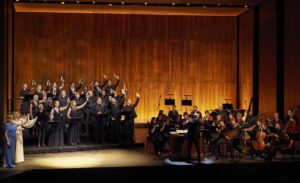
Opera Australia 2023-24 Review: Theodora
By Gordon Williams(Photo Credit: Keith Saunders)
Opera Australia’s summer season continued on February 8 with a chance to hear Handel’s favorite among his oratorios.
What was it? 1739’s “Saul?” “Messiah” of 1742? Neither.
In a coproduction with baroque specialists Pinchgut Opera, Opera Australia presented “Theodora,” Handel’s oratorio from 1750. This was a semi-staged version directed by Lindy Hume, who has been Opera Australia’s guest creative director over the summer prior to Jo Davies’ assumption of the role of artistic director. Music was provided by a fine line-up of soloists alongside Pinchgut Opera’s regular choir, Cantillation, and ensemble, the Orchestra of the Antipodes, all under the insightful and devoted direction of Pinchgut’s artistic director, Erin Helyard. It was an opportunity to assess Handel’s view of his work against our own impressions.
Handel acknowledged that audiences of his own day did not exactly flock to “Theodora.” In fact, much to his chagrin, they preferred oratorios like “Messiah.” In his thickly-accented English he complained to a couple of musicians: “You would not go to ‘Theodora’–there was room enough to dance there, when that was perform!” But it is not hard to see why “Theodora” may have challenged audiences back then, and may still do so today. A committed early Christian, Theodora is prepared to sacrifice her life rather than celebrate a feast to Jove. It is a story about faith. Fair enough–Handel and his librettist Thomas Morell were entitled to their world-view–but there is not the sort of struggle that an audience might be expecting in popular theater. The text seems more like devotional poetry.
Theodora professes her faith and reiterates it. Even when taken, “trembling,” to a brothel to test her chastity, her virtue very quickly “prompts the steady mind to prove/ Its native strength in deeds of highest honor.” Neither she nor the male lead, Didymus, experience any of the temptations to recant that might lead to three-dimensional dramatic characterization. Could it be that audiences in Handel’s day found the drama of “Theodora” uninflected, even though the story has a more convincing line than “Messiah?” But tickets to the two performances of “Theodora” offered by Opera Australia were much sought-after, and audiences seemed delighted with the results of this joint Opera Australia-Pinchgut effort.
Hume and Helyard deserve great credit for the theatrical viability of this presentation. You could almost forget that this was a presentation “in concert,” such was the effectiveness of Hume’s staging–made even more dramatic by lighting designer Jason Morphett. In Act Two, Theodora’s white gown virtually glowed under Morphett’s lighting–an apt illustration of the rapt state of her mind. Chorus and orchestra defined a small acting space that was downstage-left, from the audience’s perspective. This elevated the significance of entrances and exits and simple effects. An apt example was the staggered rising to their feet of the ensemble in Handel’s own favorite chorus; “He saw the lovely youth, Death’s early prey…” This is an account of Lazarus’ being raised from the dead–proof of Christ’s power (it could be said) that is recounted rather than seen. And there was even a scene where orchestral layout became a factor as Australian flute soloist Mikaela Oberg came into the acting area at the beginning of Act Two to bookend Australian-British soprano Samantha Clarke’s “With darkness deep as is my woe…” with halting contemplative notes. Orchestral Layout-as-Drama? But of course! This was also musically telling as Clarke vocally revealed the dark despair in Theodora’s soul in this moment, and Oberg maintained compelling intensity in the flute part’s thoughtful silences.
The ‘Christians’ in the cast–Clarke as Theodora, American counter-tenor Christopher Lowrey as Didymus, and Australian-British mezzo-soprano Helen Sherman as Lynda, Theodora’s handmaiden–gave us sympathetic portrayals of Christian conviction. What was the enthusiasm these early Christians must have felt? There was certainly rich hue in Clarke’s interpretation: a three-dimensional musical characterization. And even just in changing colors on the single syllable ra in “The rapturous soul defies the sword,” Lowrey gave us a convincing portrayal of rapture.
Australian tenor Michael Petruccelli was a sympathetic Septimius, the Roman soldier who would side with Theodora and Didymus if he could. Australian bass David Greco was the Roman governor Valens who has proclaimed the celebration in honor of Emperor Diocletian. Greco conveyed villainy in telling use of exaggerated emphasis, as when he sang “Racks, gibbets…” or pronounced the silent syllable in “fame-uh.” Australian tenor Louis Hurley as a Messenger deserves credit for conveying information in such a musically direct manner.
The chorus in “Theodora” offers not so much commentary as confirmation or exhortation, praising Jove as Romans (“And draw a blessing down,/ On his imperial crown,/ Who rules the world below”) or alternately the Christian God (“Blest be the hand, and blest the pow’r,/ That in this dark and dang’rous hour,/ Sav’d thee from cruel strife”). Given that the work is not driven by dramatic reversals or ratcheting up of tension, the chorus’ moments of exhortation were among the most musically exciting of the evening. Perhaps the most riveting theatrical image of the night was the sight of the chorus holding up their bibles, a defiant affirmation of the beliefs Theodora would hold.
One could argue, in the context of so much being achieved through simple means, extra drama may have been effectively created with more imposing costumes. Valens and Didymus wore business suits. Septimius’ military uniform–albeit a modern one–said so much more. Theodora’s glowing white gown captured by Morphett’s lighting was appropriate for her fervor. Consistent assignation of costumes to denote status might have raised the temperature of the whole night just that little bit more. But how low was the heat, after all, when you think that this was a production that could be appreciated just as much in its after-glow?


